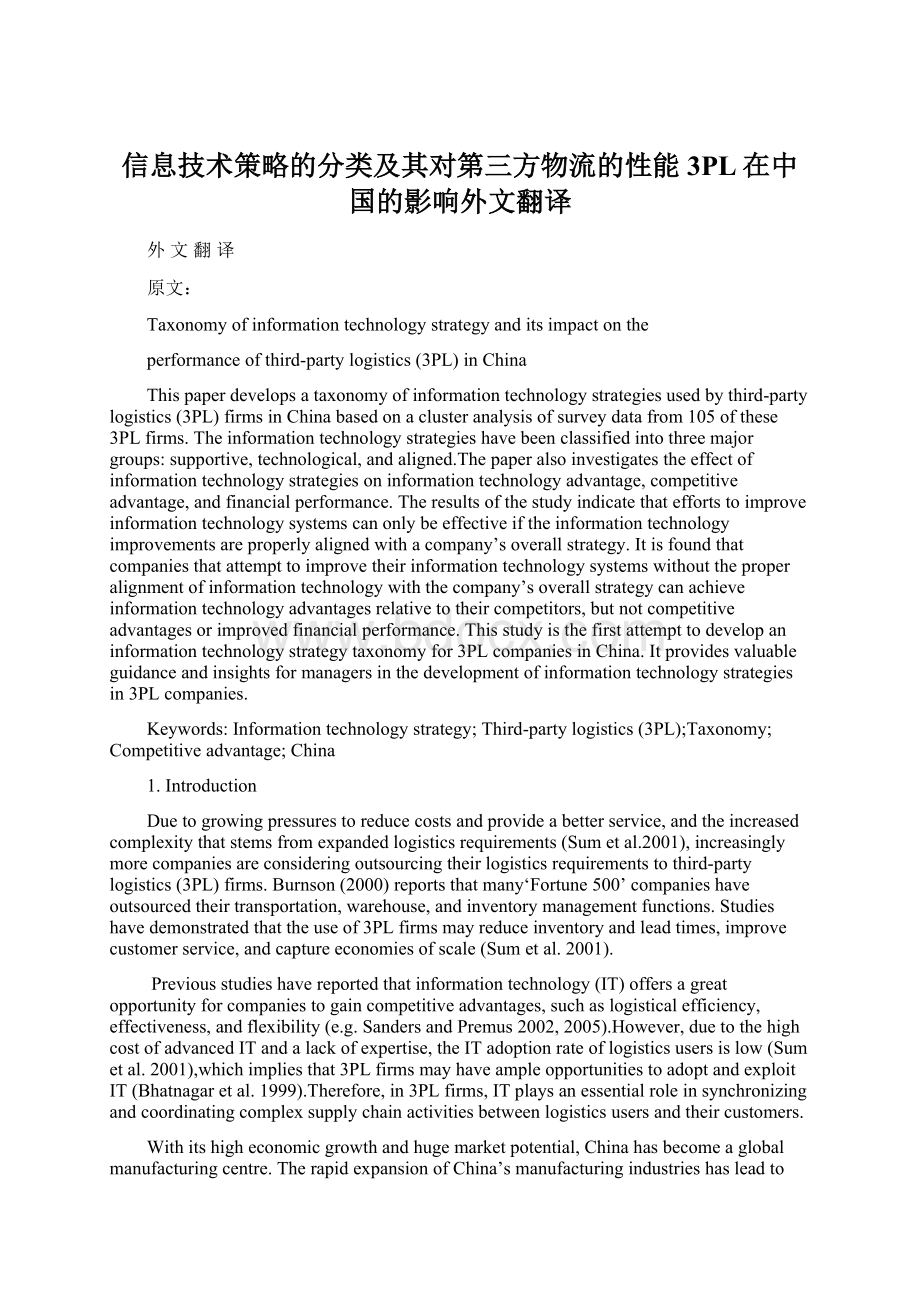信息技术策略的分类及其对第三方物流的性能3PL在中国的影响外文翻译.docx
《信息技术策略的分类及其对第三方物流的性能3PL在中国的影响外文翻译.docx》由会员分享,可在线阅读,更多相关《信息技术策略的分类及其对第三方物流的性能3PL在中国的影响外文翻译.docx(7页珍藏版)》请在冰豆网上搜索。

信息技术策略的分类及其对第三方物流的性能3PL在中国的影响外文翻译
外文翻译
原文:
Taxonomyofinformationtechnologystrategyanditsimpactonthe
performanceofthird-partylogistics(3PL)inChina
Thispaperdevelopsataxonomyofinformationtechnologystrategiesusedbythird-partylogistics(3PL)firmsinChinabasedonaclusteranalysisofsurveydatafrom105ofthese3PLfirms.Theinformationtechnologystrategieshavebeenclassifiedintothreemajorgroups:
supportive,technological,andaligned.Thepaperalsoinvestigatestheeffectofinformationtechnologystrategiesoninformationtechnologyadvantage,competitiveadvantage,andfinancialperformance.Theresultsofthestudyindicatethateffortstoimproveinformationtechnologysystemscanonlybeeffectiveiftheinformationtechnologyimprovementsareproperlyalignedwithacompany’soverallstrategy.Itisfoundthatcompaniesthatattempttoimprovetheirinformationtechnologysystemswithouttheproperalignmentofinformationtechnologywiththecompany’soverallstrategycanachieveinformationtechnologyadvantagesrelativetotheircompetitors,butnotcompetitiveadvantagesorimprovedfinancialperformance.Thisstudyisthefirstattempttodevelopaninformationtechnologystrategytaxonomyfor3PLcompaniesinChina.Itprovidesvaluableguidanceandinsightsformanagersinthedevelopmentofinformationtechnologystrategiesin3PLcompanies.
Keywords:
Informationtechnologystrategy;Third-partylogistics(3PL);Taxonomy;Competitiveadvantage;China
1.Introduction
Duetogrowingpressurestoreducecostsandprovideabetterservice,andtheincreasedcomplexitythatstemsfromexpandedlogisticsrequirements(Sumetal.2001),increasinglymorecompaniesareconsideringoutsourcingtheirlogisticsrequirementstothird-partylogistics(3PL)firms.Burnson(2000)reportsthatmany‘Fortune500’companieshaveoutsourcedtheirtransportation,warehouse,andinventorymanagementfunctions.Studieshavedemonstratedthattheuseof3PLfirmsmayreduceinventoryandleadtimes,improvecustomerservice,andcaptureeconomiesofscale(Sumetal.2001).
Previousstudieshavereportedthatinformationtechnology(IT)offersagreatopportunityforcompaniestogaincompetitiveadvantages,suchaslogisticalefficiency,effectiveness,andflexibility(e.g.SandersandPremus2002,2005).However,duetothehighcostofadvancedITandalackofexpertise,theITadoptionrateoflogisticsusersislow(Sumetal.2001),whichimpliesthat3PLfirmsmayhaveampleopportunitiestoadoptandexploitIT(Bhatnagaretal.1999).Therefore,in3PLfirms,ITplaysanessentialroleinsynchronizingandcoordinatingcomplexsupplychainactivitiesbetweenlogisticsusersandtheircustomers.
Withitshigheconomicgrowthandhugemarketpotential,Chinahasbecomeaglobalmanufacturingcentre.TherapidexpansionofChina’smanufacturingindustrieshasleadtorapidgrowthinthelogisticsindustry.TheaverageannualgrowthrateofthelogisticsindustryinChinafrom1992to2004was22.2%,andlogisticsexpenditureaccountedforanaverageof21.8%ofthegrossdomesticproductduringthisperiod(LogisticInformationCenterofChina2005).AccordingtoareportjointlypublishedbyMercerManagementConsultingandtheChinaFederationofLogisticsandPurchasing(2002),theoutsourcingoflogisticsandtransportationwillcontinuetoexpandatarateofapproximately25%peryear.
DespitethegrowingimportanceofthelogisticsindustryinChina,therehasbeennoprevioussolidempiricalresearchintoITapplicationsinChinese3PLfirms,andthereisthereforeanurgentneedforsuchempiricalstudies.TheobjectiveofthisstudyistoinvestigateITstrategypatternsandtheireffectontheperformanceandcompetitiveadvantagesofChina’s3PLfirms.Specifically,thisresearchhastwoobjectives:
todevelopataxonomytodescribedifferentITstrategiesin3PLfirms;andtostudytheeffectofITstrategyontheperformanceandcompetitiveadvantageof3PLfirms.
Inthefollowingsections,thetheoreticalbackgroundandtheresearchhypothesesarepresented,followedbyadiscussionoftheresearchmethodology.Thisisfollowedbytheanalysesandresults.Finally,theconclusionsandlimitationsofthestudyarepresented.
2.Theoreticalbackgroundandresearchhypotheses
ManyauthorshavefoundthatITcanenhancelogisticscompetitiveness(Kerr1989,Introna1991,Daugherty1994,BowersoxandDaugherty1995,Daughertyetal.1995)becauseITusecansetafirmapartfromitscompetitors(Clossetal.1997).Moreover,ITisoneofthefewproductivitytoolsthatincreasecapabilitywhiledecreasingcost.TheproperuseofITinlogisticscanimproveservices(BowersoxandCloss1996,Clossetal.1997)andenhanceproductivity,flexibility,andoperationalcompetitiveness(Daughertyetal.1995).
AlthoughITisconsideredtobeakeycomponentoffuturelogisticssystems(Dawe1994)andthereisanincreasingtrendintheuseofITapplicationsinlogistics(LaLondeandAuker1995),manymanagersremaincautiousabouttheuseofITduetothehighcostoftechnology,therisksoforganizationaldamageduringimplementation,andthelackofdemonstratedeffectiveness(Sumetal.2001).Therefore,theadoptionrateofadvancedITsystemsisstilllow.OtherreasonsthatfirmscontinuetohesitatetoinvestinITincludetherapidobsolescenceofhardwareandsoftware,applicationredundancy,andtheirrelevanceofapplicationstoafirm’sparticularindustryandinformationneeds(Dawe1994).Bowersoxetal.(1989)refertotheinabilityorunwillingnessofmanagerstoadoptITdespiteitspotentiallypositiveimpactonafirm’ssuccessasthe‘informationgap’.Forthesereasons,manylogisticsuserfirmsembrace3PLfirmstoharnessthebenefitsofadvancedITsystemsforthemanagementoftheirlogisticsfunctions.
However,ITdoesnotworkalone.Themission,objectives,andplanforITimplementationshouldsupportandbesupportedbytheoverallmission,objectives,andplansofthecompany(ReichandBenbasat1996).LucasandTurner(1982)proposeatheoreticalmodelfortheroleofITandclassifyITapplicationsintothreetypes:
.TypeI(Independent):
ITisusedtoimprovetheoperationalefficiencyofroutinetransactionsandreporting,butcompaniesinthiscategorydonotdirectlylinkITtothecompany’sstrategy.
.TypeII(Policysupport):
ITisdesignedtohelpformulateastrategicplanbutisnotpartofthestrategicplan.Generally,incompaniesinthiscategory,ITaidsrepetitivedecision-making.Examplesincluderiskmanagementinformationandschedulingsystems.
.TypeIII(Fullyintegrated):
ITbecomesapartofacompany’sstrategyandexpandstherangeofstrategicalternatives.
Onthebasisoffieldinterviewswithexecutivesfrom11industriesthatincludedbanking,diversifiedfinancialservices,oil,food,hotel,pharmaceuticaldistribution,
industrialproducts,airline,supermarket,consumerproductmanufacturing,andofficeequipment,JohnstonandCarrico(1988)alsoproposeathree-prongedmodeltodescribetheextenttowhichITisintegratedintostrategy:
.TypeI(Traditional):
theroleofITfocusesprimarilyonimprovingadministrativeandoperationalefficiency,butITisnotstrategyrelated.
.TypeII(Evolving):
ITsupportstheexistingbusinessstrategybutisnotexplicitlyconsideredduringbusinessstrategyformulation.OrganizationsinthiscategorydefineanddeveloptheirbusinessstrategieswithoutregardforthestrategicpotentialofIT.Oncethebusinessstrategyisdefined,theITfunctionactivelyseeksoutopportunitiestoapplyITtosupportthestrategy,whichmeansthattheroleofITroleisreactive.
.TypeIII(Integrated):
ITbecomesintegratedintobusinessstrategyformulationandisinconstantalignmentwiththatstrategy.CompanieswithinthiscategoryuseITtocreatenewproductsorservicesandalterlinkageswithsuppliersandcustomers,whichmeansthattheroleofITroleisproactive.
Venkatraman(1991)alsodevelopedathree-typetheoreticalmodelforintegratingITintostrategythatissimilartothemodelsthatwereproposedbyLucasandTuner(1982)andJohnstonandCarrico(1988):
.Type1(Independent):
ITdesignisindependentofstrategicplanningandaimstoimproveoperationalefficiency.CompaniestreatITasan‘administrativeexpense’.
.TypeII(Reactive):
ITdesignisderivedfromthestrategiccontext,andthestatusofITinthecompanyisincreasing.CompaniestreatITasa‘businessexpense’.
.TypeIII(Interdependent):
ITdesignaimstoachieveadynamicco-alignmentbetweenthestrategiccontextandtheITinfrastructure,andITisusedtoidentifyandrespondtobusinessopportunities.Companieshaveamoredynamicandconstantlychangingmodel,andbothstrategicmanagersandtechnologistshavethecommongoalofexploitingtechnologyforcompetitivebenefits.CompaniestreatITasa‘businessinvestment’.
3.Discussionandconclusions
ThisstudyisthefirsttodevelopanempiricaltaxonomyofITstrategiesfor3PLfirms,andtherebycontributessignificantlytotheITliteraturebyempiricallytestingsomepreviousconceptualmodelsusingdatacollectedfrom3PLfirmsinChina,andbyextendingthetaxonomyofITstrategyto3PLfirms.ThisstudyalsocontributestotheliteraturebyprovidingempiricalevidenceoftherelationshipsbetweenITstrategy,ITadvantage,competitiveadvantage,andthefinancialperformanceof3PLfirms.Althoughthethree-clustertaxonomythatisdevelopedinthisstudyprovidesempiricalsupportfortheconceptualmodelsofITstrategiesproposedbyLucasandTuner(1982),JohnstonandCarrico(1988),andVenkatraman(1991),therearealsosomeinterestingdifferencesbetweenthisstudy’sempiricalfindings